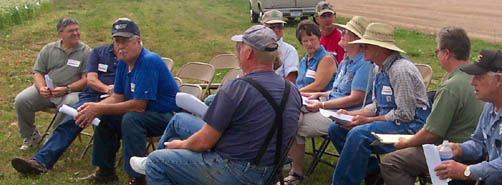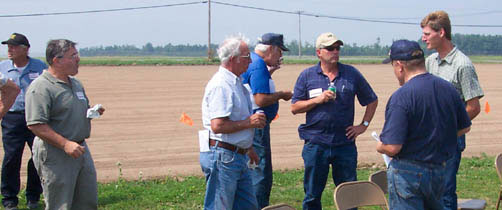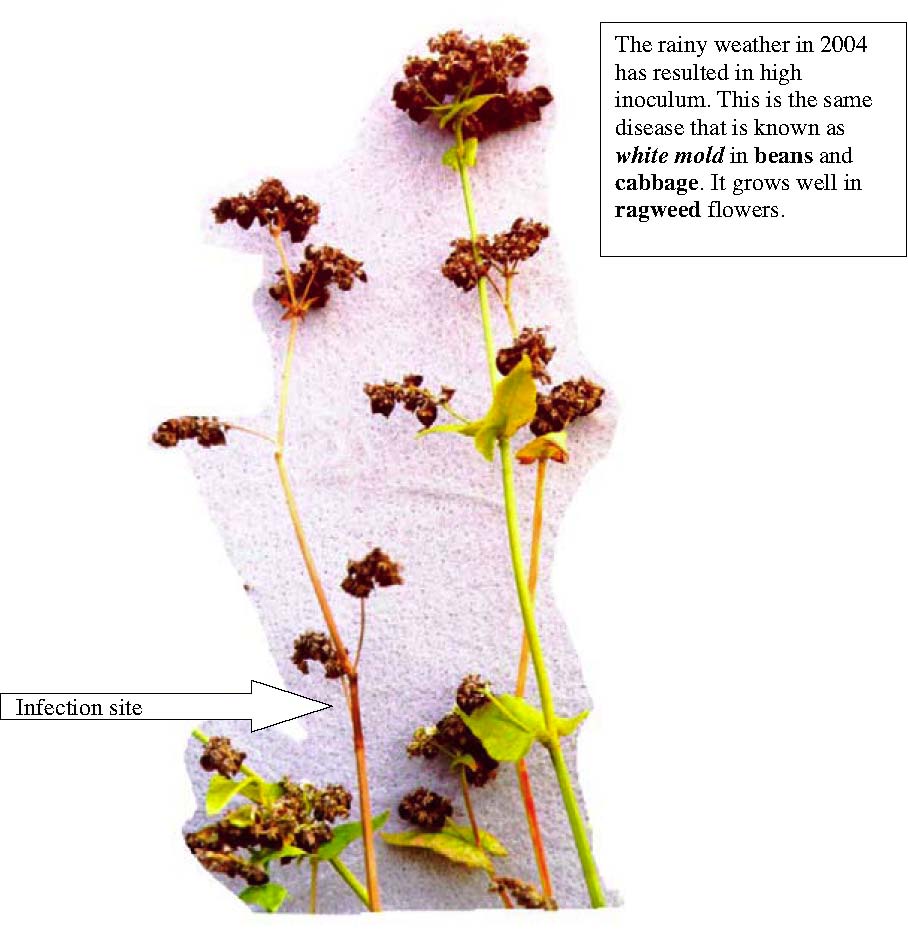Northeast Buckwheat Growers Newsletter
No. 18 September 2004
Edited by Thomas Bjorkman, Cornell NYSAES, Geneva NY
- 2004 Field Day in western New York
- Stem rot
- Research news
- East is East, West is West
- Buckwheat marketing
2004 Field Day in western New York
The 2004 Northeast Buckwheat Field Day was held in Batavia, NY on Wednesday, August 25th. Growers from all over Western New York attended and participated in informative discussions. It was hosted by ACDS Research, the managers of the New York Crop Research Facility and Farm Manager Jeremiah Smith. The field day handout is available here. HTML|PDF
 The program emphasized the role of plant population and nitrogen. High populations (70 - 100 lb/ac) are used for weed control, but result in weaker stems. Low populations (35 - 40 lb/ac) reduce lodging but can let weed seedlings escape. While the canopies were identical, normal density plants had firm stems, but high-density plants were very soft.
The program emphasized the role of plant population and nitrogen. High populations (70 - 100 lb/ac) are used for weed control, but result in weaker stems. Low populations (35 - 40 lb/ac) reduce lodging but can let weed seedlings escape. While the canopies were identical, normal density plants had firm stems, but high-density plants were very soft.
We saw weed seedlings under the canopy, but they stopped growing at about the 2-leaf stage and did not flower. Where the drill rows were 7 inches apart, weeds were well suppressed. If that space was increased to 12 inches (between drill passes), weeds grew well. In this field, it was obvious that weed suppression extended only four or five inches from the plant. Further away weed seedlings got enough light to thrive. The distribution of plants seemed more important than the population per acre.
The field day site has been used for vegetable and potato production in recent years. It has high fertility, but the tilth had declined enough that it needed a rest. Buckwheat was part of the restorative rotation. Nitrogen was broadcast at 25 and 50 lb per acre in two plots within the field which otherwise had no nitrogen added. After close inspection at the field day, nobody could find any crop response. The current recommendation to use little or no nitrogen on fields previously in vegetables or field corn was confirmed in this site.
Frequent heavy rain was the story for this season, and the field day provided a good opportunity to show how that impacts buckwheat production. Parts of the fields showed how dramatically excess water reduces growth. This year had so much rain that cloudbursts often followed planting. In this field, most of the land produced well, but there was severe stunting in two kinds of places. One kind was headlands, where compaction slowed infiltration long enough to harm the seedlings. The other kind was low spots, to which water ran off during heavy rains. That part of the field had to absorb extra water, which took long enough to stunt plants. Earlier research has showed that even 2 to 4 hours of saturated soil causes seed rot that stunts seedlings. That means small differences in infiltration rate make a big difference in crop performance. If a field can soak in an inch of rain in less than an hour rather than two hours, it makes a big difference. Water that sits in the top couple of inches stunts plants and reduces yield; water that goes deeper encourages crop growth and improves yield.
Stem rot
The rainy weather in 2004 has resulted in high inoculum levels of the fungus that causes stem rot (Sclerotinia sclerotiorum). This same disease is known as white mold in beans and cabbage. It also grows well in ragweed flowers. These plants near buckwheat could provide abundant stem rot inoculum.
Stem rot can sweep through a field near harvest. It begins as small brown spots on the stem. The stem then turns pale and dehydrated. The stems appear to weaken when the seeds are fairly mature. Seeds fall off easily and eventually the stem topples. Once toppled, the plants are hard to find. The disease may never be discovered, but the yield loss can be significant. The remedy for the disease is timely harvest.
(Click image to enlarge)
Research news
Buckwheat is helpful for maintaining beneficial microbe populations in the soil. These microbes play important roles in soil organic mater accumulation, pathogen suppression, and nitrogen availability. Jude Maul, a doctoral student at Cornell University, compared a number of different cover crops to see how they influence the collection of bacteria that live around its roots. He planted buckwheat and other cover crops into soil that had a long history of corn, then used lab techniques to characterize the soil bacterial community.
Maul found that buckwheat had greater bacterial diversity than the common cover crops, vetch and winter wheat. Buckwheat may be good at influencing the growth of soil bacteria and therefore has the potential to be used to facilitate a beneficial soil bacterial community. A beneficial or mutualistic soil microbial community could benefit subsequent cash crops.
East is East, West is West
One of the motivations for having a Northeast version of buckwheat production information is that there are some distinct differences from the Northern Plains. There has been a more applied research and extension done on buckwheat in North Dakota than the whole rest of the country. Their extension publications are often considered the definitive source of buckwheat information. Dr. Duane Berglund revised the NDSU production guide last year. (D. R. Berglund 2003. Buckwheat Production. NDSU Extension Service Publication A-687.)
Regional differences in crop behavior that are important for making management decisions, so some North Dakota guidelines are not appropriate in the Northeast. Here are some examples taken from Dr. Berglund's publication.
Planting date:
North Dakota: Buckwheat should be planted when danger of spring frost has passed. Seeding from May 25 to June 10 is suggested. When seeding is delayed beyond mid-June, severe yield reductions may occur due to frost. Later dates of planting result in a shorter growth period, shorter plants, slightly lighter seed, lower bushel weights and reduced seed yield.Northeast: Buckwheat should be planted in early July. When seeding is earlier, substantial reductions in yield occur due to big vegetative plants and uneven ripening.
Determinacy:
North Dakota: Buckwheat has an indeterminate growth habit with the top of the plant flowering while seed at the base of the plant may be already mature.Northeast: The shorter August daylength in the Northeast makes the same varieties of buckwheat behave as if they are determinate. All the seed is set by the time flowering peaks, so late flowers produce no seed. Flowering generally shuts down during seed maturation. The ripest seeds are not at the base of the plant, but about 1 foot down from the top. That is where the top of the plant was when it started to bloom. Lower branches bloom later.
Harvest time:
North Dakota: The optimum time for swathing to obtain maximum yields is when flowering is near completion and about 25 percent of the seeds are still green.Northeast: Buckwheat matures more uniformly, so there is less concern about losing the early-maturing seeds to shattering. Most buckwheat is direct cut, so more maturity is needed for the grain to thresh cleanly and for the moisture content of the threshed grain to be low enough for handling. Checking the ease of threshing by hand is a better predictor of the best time to harvest.
Phosphorus fertilizer:
North Dakota: It is a heavy feeder of mineral fertilizers, especially phosphate and this should be considered in fertilizing the crop following buckwheat.Northeast: Buckwheat usually responds to heavy fertilization with reduced yield. Excess fertilizer encourages vegetative growth at the expense of seed production. It rarely responds to phosphorus fertilizer, and phosphorus deficiency in subsequent crops has not been reported by farmers.
The difference in fertilizer response is partly the need in the Northeast to restrain buckwheat's tendency to get viny. It is also because our soil minerals include phosphates that can be solubilized by buckwheat roots. Furthermore, manure application is more common here, and its residual phosphorus is present in many buckwheat fields.
Some things are the same in the two regions.
Local growers have reported yields of 0 to 2,000 pounds per acre.
Variable and unpredictable, weather conditions make the difference between great crops and complete failures. In the Northeast, site selection, soil preparation and timing planting are the practices that improve the odds.
Buckwheat stubble adds very little organic matter and leaves the soil loose and more subject to erosion than small grain crops.
Plains farmers have converted almost entirely to high-residue winter management. The trend is much slower in the Northeast. Protecting the soil from winter erosion is important. Here, it is warm enough that we can plant a winter cover crop after buckwheat to protect the soil.
Buckwheat is almost always grown under contract.
There are a few big processors in the Plains that contract their entire production. In the Northeast, The Birkett Mills is the main buyer. Its entire production is with pre-planting contracts. Many small mills also use contracts or use the same growers every year to assure that they will have the supply they need.
Buckwheat marketing
The Birkett Mills has entered a new market with Cream of Buckwheat cereal. A product that has in the past been distributed with ethnic foods to supermarkets is now being produced as a Certified Organic product and distributed to health food stores and the health food section of supermarkets. The introduction of this product is expected to sustain or increase demand for organically grown buckwheat in the Northeast.
And a thought for the election, featuring a different kind of buckwheat marketing:
"We pray that God enlightens people's minds and doesn't let voters sell their votes for buckwheat." --Patriarch Filaret, of the Ukrainian Orthodox Church in Kiev 2004.
